

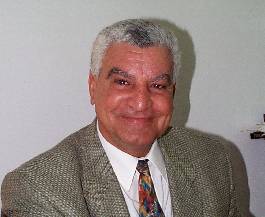

I again met with Dr. Hawass on March 23, 1998
in his office on the Giza Plateau. Here's what we talked about this time:
Guardian: The sphinx has just undergone a long restoration. Tell us about the
work and the recent reopening of the Sphinx.
Dr. Hawass: We were working on the Sphinx for the last ten years. This project
is very important because it's done by Egyptians. The first phase was the south side. For
the past 5 years we've restored and now finished the north side. The north side was a
big problem because the proportions are completely refinished and therefore we found
that the cement on the bottom of the Sphinx was about 3m thick, so we removed this cement
mechanically, because when you put cement over limestone you stop the breathing of the
limestone. Then we replaced the cement with mortar made of lime and sand, the natural way.
We also built a wall to separate between the site pollution of the people in the village
as well as the Sphinx. That square used to have cars. We are not allowing any cars now, we
have a parking lot away from the Sphinx; the site looks really quiet now.
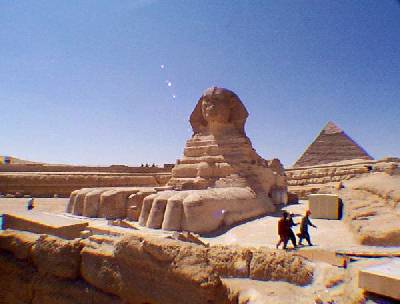
Dr. Hawass: We will soon make a big celebration onto the Sphinx, we'll invite important VIP's, people from all over the world and we'll make a celebration for the reopening of the Sphinx.
Guardian: When will this be?
Dr. Hawass: It should be the 2nd week of April. The people will be sitting in front of the Sphinx, listening to speeches, after that we'll bring a Symphony. It's a really big celebration because the Sphinx was the symbol of a whole nation in ancient Egypt and it still is the symbol of Egypt today. I also have to say that's it's very important to understand that we haven't completely finished the entire restoration of the Sphinx but it's important that people from all over the world get to see it again. This year we also celebrated the Equinox on the shoulder of the Sphinx, the 21st of March. This day comes only only twice a year and this is very important to prove that the Egyptians when they carved the Sphinx they did not really make it as haphazard, they intended really to cut the Sphinx here to be connected with the sun.The other important thing that we did is the opening of the tombs in Giza. We opened 10 tombs to the public, we opened also the Queen's pyramids of Khufu for the first time.
Guardian: I know that you rotate the restoration of the Giza pyramids, generally leaving two open and one closed for restoration. You recently reopened the third pyramid, that of Menkaura. Is the true that the next pyramid to undergo restoration will be the Great Pyramid?
Dr. Hawass: We're going to close the Great Pyramid on April 1st, because we found inside the pyramid again after 6 years, salts deposited on the walls up to 2 cm thick, and we also found cracks and graffiti left by the people and therefore we will close this for 8 months to restore these things. Then we'll open to the public the 1st burial chamber and the so-called Queen's Chamber and we'll do this cleaning and this restoration, mechanically removing all the salt, but also, at the same time we will make a new ventilation system with the French expedition. You know we are not closing the pyramid to hide anything as people say. We are not discovering anything in the Great Pyramid, there is nothing really remaining to be discovered inside.
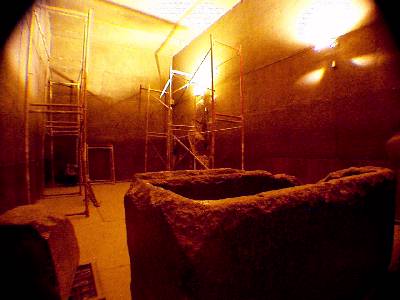
Dr. Hawass: Even though we were prepared to investigate the so-called "door" inside the pyramid that was found by Gantenbrink. We found that in Gantenbrink's report when he recently visited me, looking more closely at the video tape, we see that there really is no crack or an open area that we can send a robot. We found that there is no shaft or small area, underneath this stone to send a small robot or anything, this means that we are not going to be able to investigate and see what's behind it.
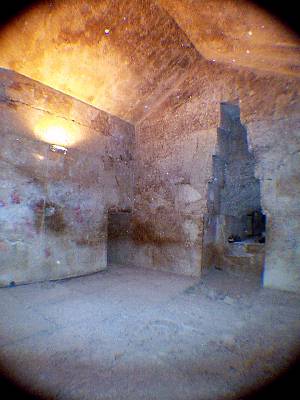
The northeast corner of the Queen's Chamber of the Great Pyramid
Guardian: There's no crack on the bottom of the slab
found by the robot at the end of the shaft that would allow even a small camera?
Dr. Hawass: There's no crack on the bottom, exactly. This is what the media
created and I never received a proper report from Gantenbrink, because of the problems
that we had with him. But when I met him last week and when he showed me in the videos
here what it looks like in there, we did not really see any crack in the fitting. And
therefore, it's very difficult to decide to do anything further with this.
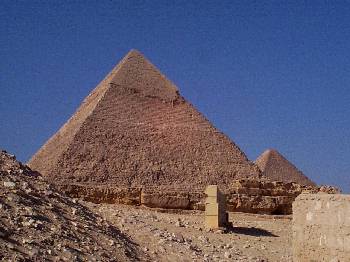
Dr. Hawass:
As another part of my plan to conserve and manage the plateau, 5 KM south of the third pyramid, we finished by today building a stable for horses. In a few months from now, near this stable, in the desert south a big parking lot for the tourists and a picnic area for the Egyptians. So when the Egyptians start the feast, which they come in number to the pyramids to celebrate and eat, they will have a picnic area. And we'll open an entrance to the plateau from the Fayoum road, then tourist buses will come from Fayoum Road there, on the west, and they will enter the plateau, and they can park their cars, and ride camels and the pyramid will be the background. No camels will be allowed to enter inside the plateau. This will happen in three months, maximum. This is part of the newest phase of management of the pyramids. We're talking to the Japanese now to see if they can help us to move the Khufu Solar Boat from this museum beside the Great Pyramid, and restore the second boat, and move both boats to two new museums that we will construct at the entrance of Fayoum Road. The when the tourists visit, they can park their cars, they visit the boats, and they go up to the plateau. The final phase of my site management plan is really the whole conservation of the Giza Plateau. We will finish the so-called tourist road around the plateau that will contain all the cars and no cars will be allowed to go right up to the pyramids. At the same time we will have electric cars for tourists, we are talking to a company in the United States now, they're going to provide us with these electric cars. They will take people to tombs and no pollution will be affecting the pyramids from the tourist cars and busses. We'll also build this Cultural Center in the desert and this center is very important because it will allow for Egypt to make more income and the more income means that the people will only pay for the tickets to enter the pyramids. But this will be very important, they still sell postcards, souvenirs, and also at the same time even make a kind of certificates for people to visit the pyramids and assign them to anyone. This is really a source of income that can help us in the accommodation of the plateau.
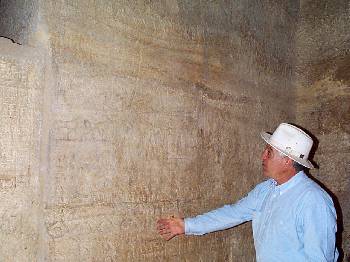
Dr. Hawass points out an inscription in the newly opened Tomb of Debhen
The tombs that were just opened here are fantastic, an impressive kind of restoration work and we are continuing now other restoration, of four tombs. From the newly opened tombs, ones that are from Khafre's section, two are unique because they have beautiful architectural style, and another one, the Tomb of Debhen, which has a very unique text in it, because it is the first time that an owner of the tomb left an inscription inside the tomb telling us that he asked the King Menkaura to build the tomb for him. And the king agreed and he asked the overseer of the work to bring the stones to build his tomb. But Debhen, in his tomb said, that the king was standing looking at his pyramid, behind him was the "Hr" pyramid. We don't really know what this "Hr" Pyramid is. This is really another mystery of the pyramids.
The Queen's pyramids that we finished now they're open to the public, and the other excavation that we are doing, remember at the third pyramid, where we discovered last year the pair statue of Ramesses II. This year we are excavating and re-excavating an area near the east side of the pyramid and they are cleaning three tombs that we have just found since last week! And this is another very impressive excavation. In the tombs of the workmen we are continuing to work. We found just a tomb last week, a big, large limestone tomb in the area of the cemetery of the artisans. We discovered many interesting things about the boats, and we found that the ancient Egyptians had emergency medical treatment for the workmen. We found 12 skeletons of the workman, they had broken hands from the stones, and they did put wooden splints around these broken hands. We found one had a broken legs and they also had cut his leg in an operation and evidence suggests that he lived for 14 more years.Guardian:
The passageway on the north side of the Sphinx, which is no mystery, it was probably a robbers tunnel that was already opened in 1926, but you have mentioned that you may explore it again at one point?Dr. Hawass: We thought we would. But then we realized that to do this would only cause undue damage to the this part of Sphinx.
Guardian:
How about in front of Khafre's valley temple? I know you had found that canal. Is there anything further excavating going on there or east of there?Dr. Hawass:
In front of the Valley Temple, you know my interpretation now is that we discovered the evidence of the purification tents outside and we found a place, a platform, a mudbrick platform that the royal family would stand to watch while they were purifying the dead king. The two tunnels, in my opinion, contained two symbolic boats. It is the manner of the ancient Egyptians that the king as Horus will use the one boat in the north to control the north, and the one in the south to control the south. The sloping of the ramp, we believe that a harbor existed in that area. and the end of the harbor connected with this ramp. There are circuits above the top of the ramps proving the existence of two tools, meaning that these two ramps were sealed.Guardian:
Is there anything new on Khufu's valley temple? I know you've discovered the remnants of it to be under the village.Dr. Hawass:
We discovered it, but we do not really yet have plans to do more work on it, at least we discovered the location and the route of the entire causeway, The whole causeway is 825 meters. After 700 meters it bends at 32 degrees, and it goes again for 125 meters until you reach the causeway.Guardian:
You've been excavating on the south side of the Menkaure pyramid, are you looking for the entrances to the satellite pyramids there?Dr. Hawass:
We will open one of these pyramids soon. One of the Queen's pyramid, the last one of Ipymon was not opened since perhaps ancient times since Dynasty 4. That it why we are going to re-open that.Guardian: So, you've already located the opening for this pyramid?
Dr. Hawass: We already have located this. We will perhaps be opening this pyramid live on television.
We are working to create a schematic for the granite stones on the Menkaure pyramid. After that we will see if we can find a way to return some of the granite stones to their original placements. We are still looking for the ramps which the Egyptians used to transport the stones. We are also still looking for the solar boats of Menkaure.
Guardian: You have found evidence of ramps on the south side of the pyramid of Khufu. Are these recovered or are they visible?
Dr. Hawass: They are still exposed and can be seen. I will show you these later.
Guardian: Can you tell me a little about the tomb you recently discovered at Abu Sir?
Dr. Hawass: This is the first intact tomb of an official that we have found. This is the first time for this and this man was a director of the palace in the 26th Dynasty . I mean he was a very powerful man. Before this tomb, the Czech expedition found another tomb of a person who was a consultant of the Persian king Compise. The story is that this man was very important because his tomb is 28 meters down, and they found a large limestone sarcophagus. Around this they found pyramid texts, hieroglyphic texts, Book of the Dead scenes, 408 shawabtis, furniture, canopic jars, papyrus rolls, all intact. When they were collecting this the tomb became unstable from natural moisture damage so they built a concrete dome above that to reinforce the tomb. When we opened the sarcophagus we found inside an anthropoid sarcophagus made of basalt beautifully inscribed. When we took the lid up we found the third inner coffin with the mummy. The mummy was a man, 54 years of age, which was deteriorated a little bit. We would like to know his relationship to the Persians. This will be featured on the American television show Dateline shortly.
Guardian: So, no treasure was discovered in this tomb?
Dr. Hawass: No, but this is probably because this is only an official and not the king.
We are planning to open the site of Abu Sir to the public. Then the public can see the pyramids there, visit the tomb of Ptah-Shepses.
Guardian: Do you have any plans to further restore the site of Dahshur? Presently, the one can only enter the Red Pyramid there, will you eventually open the interior of the Bent Pyramid?
Dr. Hawass: I believe we may eventually, but we don't have any plans currently under way about this. We are busy with other things.
Guardian: When you reopen the Great Pyramid, which is the next in line for restoration?
Dr. Hawass: The next will be the second pyramid, that of Khafre.
Guardian: Lastly, you are going to install a new ventilation system in the Great Pyramid during this restoration period?
Dr. Hawass: Yes, this will be done by French, they have proposed to us a new system that will be better in terms of preventing such a build-up of salt deposits on the walls and other damage by tourists.
Guardian: Thank you for your time. I enjoy our meetings and working with you on your website.
Dr. Hawass: I also enjoy this and look forward to our next meeting.
The next interview with Dr. Hawass will be in March 2000! Stay tuned.
|
OTHER SPOTLIGHT INTERVIEWS |
Return
to The Plateau
Official Website of Dr. Zahi Hawass
 RETURN TO
Guardian's Egypt Main Gate
RETURN TO
Guardian's Egypt Main Gate
Guardian's CyberJourney
To Egypt
Copyright © 1998 Andrew Bayuk
All Rights Reserved